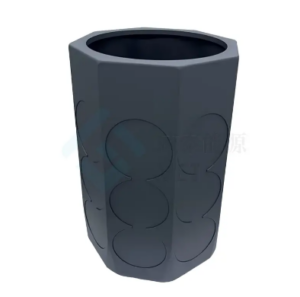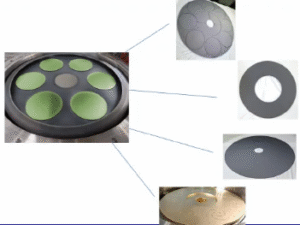
A PEM electrolyzer 最先端の機能として water electrolyzer、水素および酸素に水を分ける高度の技術を利用して下さい。 このプロセスは固体ポリマー電解物に、高性能および水素純度を保障します。 緑水素を生産することにより、PEMの電解槽は、化石燃料の信頼性を低減し、持続可能なエネルギーソリューションを発展させることに重要な役割を果たしています。 再生可能エネルギー源とシームレスに統合する能力は、グローバルなエネルギー課題に取り組む上での重要性を強調しています。 約80%の電気効率で、クリーンエネルギー生産の革新を発揮します.
要点
- PEMの電解質は効率的に水素および酸素に水を分ける高度装置で、きれいなエネルギー塗布のために必要不可欠な高純度の水素を作り出します.
- それらはおよそ80%の電気効率で作動し、それらに再生可能エネルギーの源との緑の水素の生産そして統合のための一流の選択をします.
- コンパクトな設計とPEM電解質のスケーラビリティにより、小型の設置から大型の産業セットアップまで、さまざまな用途に収まることができます.
- 超純水・再生可能エネルギーを利用したPEM電解槽は、化石燃料の持続可能な代替手段を提供することで、脱炭素化に貢献します.
- 素材のコストや耐久性の問題などの課題は、PEM技術の継続的な研究開発と革新を通じて解決されています.
- 寧波VETエネルギー技術のような企業 PEMの電解質の技術の進歩の最前線でCo.は性能を高め、コストを削減します.
- 余剰再生可能エネルギーを水素に変えることで、PEMの電解質はエネルギーを貯え、持続可能なエネルギーシステムへの移行をサポートする重要な役割を果たしています.
PEMの電解質は何ですか?
定義と基本的な概念
A PEM electrolyzer 水素と酸素を電気化学プロセスで分割する先進装置です。 それは分離器および電解物として役立つ固体ポリマー電解物の膜を使用します。 この膜は、酸素や水素などのガスを混合から遮断しながら、陽極から陰極への正充電水素イオン(プロトン)の動きを促進します。 結果は高純度水素ガスの生産です.
従来のアルカリ電解液とは異なり、PEM電解液は高い電流密度で動作し、応答時間を短縮します。 高圧条件下で機能するコンパクトで多様な用途に適しています。 超純水・再生可能エネルギーを利用したPEM電解槽は、持続可能なエネルギーソリューションの礎となるグリーン水素の発生に貢献します.
水素の生産およびきれいなエネルギーの輸入
水素製造におけるPEM電解槽の役割は変容します。 燃料電池や産業プロセスなどの用途に欠かせない水素の生産を可能にしています。 さまざまな条件下で効率的に動作する能力は、太陽光や風力などの再生可能エネルギー源との統合に理想的です。 たとえば、過剰な再生可能エネルギーの発生期間中、PEMの電解質は、このエネルギーを水素の形で保存することができ、エネルギーが無駄にならない.
クリーンエネルギーのコンテクストでは、PEMの電解質は適応性と効率性のために際立っています。 化石燃料の持続可能な代替手段を提供することで、脱炭素化の取り組みをサポートします。 PEMの電気分解によって作り出される水素はゼロ温室効果ガスを排出する間、企業のための供給の在庫として力車、発生電気および役立つことができます。 グローバルなクリーンエネルギー目標を達成する上で、PEMの電解質を重要な技術として位置付けています.
PEMの電解質はどのように機能しますか?
PEMの電解質の主成分
PEMの電解質は水素および酸素に水を分けるために一緒に働く複数の重要な部品から成っています。 各部分は電気分解プロセスの効率そして信頼性を保障するで特定の役割を担います:
プロトンの交換膜(PEM):
PEMは、電解質のコアとして機能します。 水素や酸素などのガス混入を防止しながら、通気する水素イオン(プロトン)のみを電解液として作用します。 高清浄度水素製造を実現します.電極(陽極および陰極):
陽極および陰極は電気化学反応を促進する触媒と上塗を施してあるです。 陽極では、水分子は酸素、プロトン、電子に分裂します。 陰極では、プロトンは電子と水素ガスを形成するために結合します.触媒:
プラチナやイリジウムなどの貴金属は、一般的に触媒として使用されます。 これらの材料は、反応速度を高め、電気分解プロセスをより効率的にします。 研究は、さまざまな動作条件の下で性能を向上させるために陽極触媒の最適化の重要性を強調しています.バイポーラの版:
これらのプレートは、膜と電極を均等に分散させます。 反応中に発生するガスを電気で分離する.水供給システム:
PEMの電解質のために超純水は必須です。 水供給システムは、分裂プロセスが開始される陽極に水の一貫した流れを保証します.電源:
直流(DC)電源は、電気化学反応に必要なエネルギーを提供します。 太陽や風などの再生可能エネルギー源は、多くの場合、PEMの電解質に電力を供給するために使用され、緑色の水素生産目標と整列します.
PEMの電解質の働き原則
水素や酸素への水の電気化学的分裂の周りのPEM電解槽の動作。 プロセスは3つの主要なステップに分解することができます:
アノードで水割り:
陽極では、水分子は酸化を受けます。 この反応は、酸素ガス、プロトン、電子を生成します。 この反応のための化学式は次のとおりです2H2O → O2 + 4H + 4E−
酸素ガスは副産物として解放され、プロトンおよび電子は別の道を通って陰極に移動します.
プロトン輸送 PEMを通して:
陽子交換膜は、水素イオン(H+)のみを陽極から陰極まで通過させることができます。 水素と酸素ガスの混合を防止し、水素生成物の純度を確保します.Cathodeの水素形成:
陰極では、プロトンは、外部回路が供給する電子と組み合わせて水素ガスを形成します。 陰極での反応は次のとおりです4H++4e-→2H2
カソードで生成された水素ガスは、貯蔵や即時使用のために収集されます.
PEM の電解質のための全面的な反作用はとして要約することができます:
2H2O → 2H2 + O2
このプロセスは、水素に貯蔵される化学エネルギーに電気エネルギーを変換するPEMの電解槽の効率を示します。 研究は水流率、温度および触媒の最適化のような要因がPEMの電解質の性能に著しく影響を及ぼすことを強調します。 最適な条件下で運用することで、高効率・信頼性を実現し、グリーン水素生産の礎となる.
PEMの電解質の電気化学反応
アノード反応: 酸素の進化
PEMの電解質の陽極の反作用は水割れのプロセスを開始します。 陽極では、水分子は酸化を受け、酸素ガス、プロトン、電子の放出をもたらします。 この反応は式によって表されます
2H2O → O2 + 4H + 4E−
陽極で生成される酸素ガスは副産物としてシステムを終了します。 この反応中に生成されたプロトンは、プロトン交換膜(PEM)をカソードに移行し、電子は外部回路を通過します。 この反応の効率は、陽極で使用される触媒に依存します。 イリジウムのような貴金属は、反応キネシスを高める能力のために一般的に採用されています。 研究は、温度や水純度などの動作条件を強調し、チャージトランスファーキネティックスを改善し、エネルギー損失を削減することにより、陽極反応の性能を大幅に影響します.
陰極の反作用: 水素の進化
陰極では水素の進化反応(HER)が起こります。 PEMを通過したプロトンは、外部回路が供給する電子と組み合わせて水素ガスを形成する。 陰極での反応は次のように表現されます
4H++4e-→2H2
高純度水素ガスを生産し、電気化学プロセスを完成させます。 PEMの選択的な透過性は、プロトンだけがカソードに到達し、水素と酸素ガスの混合を防ぎます。 プラチナのような触媒は、反応を加速し、効率を改善するために陰極で頻繁に使用されます。 陰極触媒を最適化し、理想的な動作条件を維持する研究ハイライトは、水素の生産率を高め、エネルギー消費量を減らすことができます.
全体的な反応およびエネルギー考察
PEMの電解質の全面的な反作用は陽極および陰極の反作用を結合し、水素および酸素に水の分裂をもたらします。 このプロセスをまとめる式は次のとおりです
2H2O → 2H2 + O2
この反応は、水素に貯蔵された化学エネルギーへの電気エネルギーの変換を実証します。 このプロセスの効率性は、膜伝導性、触媒性能、動作条件など、いくつかの要因に依存します。 研究では、適切な温度と水流率を維持し、発熱過電圧を削減し、揮発効率を増加させるなど、最適な条件を明らかにします。 これらの改善は、PEMの電解槽が高エネルギー効率を達成することを保障しま、それらに緑の水素の生産のための好まれる選択をします.
また、PEMの電解質は、再生可能エネルギー源と統合する柔軟性も展示しています。 再生可能エネルギーを活用し、環境負荷の少ない水素を生産。 この機能は、持続可能なエネルギーシステムへの移行と炭素排出量の削減にグローバルな取り組みを合わせています.
PEMの電解槽の利点
高効率・水素純度
PEMの電解質は効率で、それらに緑の水素の生産のための好まれた選択をします。 彼らの設計はそれらが印象的な電圧効率を維持している間高い現在の密度で作動することを可能にします。 この機能は電気分解プロセスの間に最低のエネルギー損失を保障します。 アルカリ電解質、PEM電解質などの他の電解質タイプと比較して、一貫して高い効率レベルを実現します.
水素純度はPEMの電解質の別の傑出の特徴です。 プロトン交換膜は、選択的な障壁として機能し、水素と酸素ガスの混合を防止しながら、プロトンだけが通過することを可能にします。 この結果は、燃料電池や産業プロセスなどのアプリケーションにとって重要な、例外的な純度を持つ水素です。 たとえば、電子機器製造などの超純水素を必要とする業界は、PEM電解質の高出力から大幅に利益をもたらします.
コンパクト設計とスケーラビリティ
PEMの電解槽のコンパクトな設計により、小規模な設置から大規模な産業セットアップまで、幅広い用途に適しています。 最適化されたフットプリントにより、限られたスペースに収まることができ、都市環境やスペース制約のある施設に最適です。 従来のアルカリ電解質とは異なり、より大きな段取りを必要とすることが多いPEM電解質は、より合理化され、スペース効率の高いソリューションを提供します.
スケーラビリティは別の重要な利点です。 PEMの電解質は容易にさまざまな生産の要求に合わせることができます。 単一の燃料電池車または大規模の水素給油場所のための水素を作り出すかどうか、モジュラー設計は継ぎ目が無いスケールを支えます。 この柔軟性は、新興国と確立された水素市場のための多目的なソリューションとしてPEMの電解槽を配置します.
再生可能エネルギー源との互換性
太陽光や風力などの再生可能エネルギー源とシームレスに統合 変動する電力入力で効率よく動作する能力は、再生可能エネルギーシステムに適している。 たとえば、過剰な太陽光や風力エネルギーの発生期間中、PEMの電解質は、余剰電力を水素に変換し、再生エネルギーを後で使用するために効果的に保存することができます.
この互換性は、持続可能なエネルギーシステムへの移行にグローバルな取り組みを合わせています。 再生可能エネルギーを利用したPEM電解槽は、環境負荷の少ないグリーン水素を生産しています。 この水素は、脱炭素化目標に貢献しながら、車両を発電したり、電気を発生したり、工業用飼料として機能したりすることができます。 再生可能エネルギー源への適応性は、クリーンエネルギーソリューションの推進に役立てています.
PEMの電解質の挑戦
高材料コスト
PEMの電解質は高性能および耐久性を達成するために高度材料に頼ります。 プロトン交換膜、重要なコンポーネント、製造に高価な特殊ポリマーを使用しています。 また、電極はプラチナやイリジウムなどの貴金属を触媒として要求します。 これらの材料は反応率を高めますが、生産コストを大幅に増加させます.
これらのコンポーネントの高コストは、大規模な採用のための課題を貫きます。 例えば、商用スケールでPEM電解質をデプロイする業界は、これらの材料を調達する金融的影響を考慮する必要があります。 研究者は、妥協することなくコストを削減するために、非貴金属触媒などの代替品を探求し続けています。 しかし、費用対効果の高いソリューションの実現は、進行中の作業を続けていきます.
耐久性とメンテナンス
耐久性はPEMの電解質のための別の重要な挑戦です。 高温および酸性環境を含む粗い作動状態は、膜および触媒を時間上の分解できます。 この分解は装置の効率および寿命に、高められた維持の条件に導く影響します.
メンテナンスは、摩耗したコンポーネントを交換し、運用コストに追加します。 たとえば、触媒や膜の交換は、時間消費と高価なことができます。 PEMの電解槽を使用しての産業は、性能の問題を早期に検出するために定期的な監視システムを実装しなければなりません。 材料科学の進歩により、重要なコンポーネントの耐久性を向上させることを目指していますが、現在のソリューションは依然として限界に直面しています.
エネルギー効率のトレードオフ
PEMの電解質は、高効率で知られていますが、最適なエネルギー効率を実現するには、トレードオフが含まれます。 作動温度、水純度および現在の密度のような要因は性能に直接影響を与えます。 より高い電流密度での動作は、水素の生産率を増加させることができますが、また、より高いエネルギー消費と削減効率につながる可能性があります.
これらのパラメータのバランスは、慎重に最適化する必要があります。 たとえば、特定のアプリケーションのニーズに基づいてエネルギー節約を優先するかどうかを業界は決定しなければなりません。 研究は、高水素純度を維持しながら、エネルギー損失を最小限に抑えるために、微調整動作条件の重要性を強調しています。 これらの努力にもかかわらず、完璧なエネルギー効率を達成することは、PEM電解質のための複雑な課題を残します.
クリーンエネルギーの未来におけるPEMの電解槽の役割
再生可能エネルギーシステムとの統合
PEMの電解質は、再生可能エネルギーシステムとの相乗効果を発揮し、持続可能なエネルギー戦略の礎となります。 太陽光や風などの再生可能エネルギー源から発生する電力を利用することで、これらの電解質は、剰余金のエネルギーを水素に変換します。 この水素は、多岐にわたるエネルギーキャリアとして機能し、再生可能エネルギーの貯蔵を後から使用できるようにします。 たとえば、高太陽放射または強風の期間中、PEM電解質は、エネルギーの無駄を防止するために、フル容量で動作することができます.
再生可能エネルギー源からの電力入力の変動に適応するPEM電解質の能力は、実用性を高めます。 従来のエネルギー貯蔵システムとは異なり、断続的な再生可能エネルギーを安定した輸送可能な形態に変換することにより、長期的なソリューションを提供します。 この統合は、再生可能エネルギーの断続的課題に取り組むとともに、クリーンエネルギーグリッドへのグローバルな移行をサポートします.
脱炭素化目標への貢献
PEMの電解質は世界的な脱炭素化の目的を達成するpivotal役割を担います。 グリーン水素を生産することで、さまざまな分野にわたって化石燃料に持続可能な代替手段を提供します。 輸送・発電・製造などの産業は、この技術で製造されたゼロエミッション水素の恩恵を受けています。 例えば、水素系燃料電池車は水蒸気だけを排出し、従来の内燃機関と比較して温室効果ガス排出量を大幅に削減します.
輸送に加えて、PEMの電解槽は、産業プロセスの脱炭素化に貢献します。 従来のカーボン集中方式に頼る鋼鉄生産およびアンモナルの統合のようなセクターは洗剤の原料として緑の水素を採用しますできます。 このシフトは、これらの業界のカーボンフットプリントを削減し、国際気候協定と持続可能性の目標に合わせます。 PEMの電解質の広範な採用は低炭素の経済への移行を加速しま、環境および経済的な利点を育てます.
シンボVETエネルギー技術有限公司は、PEMの電解質技術を開発
ニンポー VET 株式会社エネルギーテクノロジーは、PEM電解質の技術開発とイノベーションのリーダーとして誕生しました。 VETグループの一員として、このハイテク企業は、高度な燃料電池コンポーネントの製造に特化しています PEM electrolyzers、水素発生器および膜の電極アセンブリ。 研究開発へのコミットメントは、効率、耐久性、スケーラビリティの継続的な改善を保証します.
Ningbo VET Energy Technology Co.は、その専門知識を活用することで、PEMの電解質技術において重要な課題を解決します。 たとえば、コストを削減しながらパフォーマンスを向上させるために、触媒や膜の最適化に焦点を当てています。 イノベーションへのこだわりは、世界的な水素経済において重要な役割を果たしています.
さらに、寧波VETエネルギー技術 再生可能エネルギーシステムとPEM電解槽の統合を積極的にサポート 高品質のコンポーネントとソリューションを提供することで、業界はシームレスにグリーン水素技術を採用することができます。 この貢献は、持続可能なエネルギーソリューションの採用とグローバルな脱炭素化の努力の推進に取り組みます.
PEMの電解槽は、水素と酸素に水を効率的に分割することにより、クリーンエネルギーの革新を発揮します。 プロトン交換膜を中心とした運用により、再生エネルギーの統合を支援しながら、高純度の水素生産を実現します。 持続可能なエネルギーソリューションを提供し、炭素排出量を削減する上で重要な役割を果たしています。 寧波VETエネルギー技術有限公司のような企業は、PEM電解質性能とスケーラビリティを強化することにより、進捗を駆動します。 イノベーションへのコミットメントは、水素経済の礎石としてPEM電解質を配置し、グリーンエネルギーの未来に向けたグローバル移行を強化します.
よくあるご質問
水電気分解のためのPEMの利点は何ですか?
PEMの電解質はそれらに水電気分解のための好まれた選択をする複数の利点を提供します。 ザ・オブ・ザ・ プロトン交換膜(PEM)NafionTM など、この技術のコアとして機能します。 選択的にプロトンが他のガスを妨げている間通ることを可能にすることによって高い水素純度を保障します。 この機能は、燃料電池などの超純水素を必要とする用途に不可欠です。 また、高電流密度でPEM電解槽を作動させ、効率的な水素製造を実現します。 高圧条件下で機能するコンパクトな設計と能力は、その汎用性を高めます.
PEMの電解質はアルカリの電解質とどのように異なるのですか?
PEM の電解槽は複数の主要な面のアルカリの電解槽と異なっています。 PEMの電解質は電解質として固体ポリマー膜を使用しますが、アルカリの電解質は液体のアルカリの解決に頼ります。 この違いは、PEMの電解槽がより高い電流密度で動作し、電力の変動に迅速に応答することを可能にします。 また、PEMの選択的な性質により、より純度の高い水素も生成します。 対照的に、アルカリ電解槽は一般的に大きく、効率が低く、材料コストが削減されます.
なぜ超純水はPEMの電解質のために必要ですか?
PEMの電解質の操作のために超純水は重大です。 水の不純物は陽子の交換膜を分解し、電気分解プロセスの効率を減らすことができます。 汚染物質はまた、触媒のパフォーマンスに影響を与える可能性があり, 増加したメンテナンスとより短いデバイスの寿命につながる. 超純水を使用して、PEMの電解質は最適性能を維持し、高純度の水素の生産を保障します.
再生エネルギー源とPEMの電解槽は一体化できますか?
はい、PEM の電解質は太陽および風力のような再生可能エネルギーの源と継ぎ目無く統合します。 変動する電力入力を処理する能力は、再生可能エネルギーシステムに最適です。 たとえば、過剰な太陽光や風力エネルギーの発生期間中、PEMの電解質は、余剰電力を水素に変換できます。 この水素は、エネルギーキャリアとして機能し、再生可能エネルギーの貯蔵を後から使用できるようにします。 持続可能なエネルギーシステムへの移行をサポートし、化石燃料への信頼性を低下させます.
PEMの電解質で触媒が果たす役割は何ですか?
触媒はPEMの電解質の効率で重要な役割を果たします。 陽極および陰極で電気化学反応を加速させ、水素と酸素に水を分割することができます。 プラチナやイリジウムなどの貴金属は、その高い活性と耐久性のために触媒として一般的に使用されています。 たとえば、イリジウムは陽極で酸素の進化反応を高めますが、プラチナは陰極で水素の進化反応を改善します。 研究は、性能を損なうことなく、これらの貴金属のコスト効果の高い代替品の開発に注力しています.
陽子交換膜は、水素純度を確保する方法?
陽子交換膜(PEM)は、PEM電解質の選択的な障壁として機能します。 水素イオン(プロトン)は、水素と酸素ガスの混合を防止しながら通るのみを正当に充電できます。 燃料電池や産業プロセスなどの用途に欠かせない高純度水素の生産を、選択可能な透過性で実現します。 NafionTM などの膜の設計と材料組成は、この純度を維持する上で重要な役割を果たします.
PEM の電解槽からのほとんどの企業の利点は何ですか?
複数の産業はPEMの電解槽からかなり寄与します。 輸送部門は、PEMの電解槽によって生成された水素を電力燃料電池車に使用し、従来のエンジンにゼロエミッションの代替手段を提供します。 産業部門は、アンモニア合成や鋼の生産などのプロセスのためのフィードストックとして水素を採用し、炭素排出量を削減します。 さらに、エネルギー分野は、PEMの電解質を使用して、水素の形態で再生可能エネルギーを保存し、太陽光と風力の欠員に対処する.
大規模な水素製造にはPEM電解液がスケーラブルですか?
はい、PEMの電解質は非常にスケーラブルで、小規模および大規模の水素生産に適しています。 彼らのモジュラー設計は企業は要求に基づいて生産能力を調節することを可能にします。 例えば、単一のPEMの電解槽は燃料電池車のための水素を作り出すことができます複数の単位は水素の給油場所か産業設備を支えることができます。 このスケーラビリティは、PEMの電解質が新興および確立された水素市場の必要性を満たすことができることを保障します.
PEMの電解質を使用する環境への影響は何ですか?
PEMの電解質は環境に緑水素を作り出すことによって積極的に貢献します。 再生可能エネルギー発電時、炭素排出量を最小限に抑えて水素を発生させます。 化石燃料を様々な用途に交換し、温室効果ガス排出量を削減できます。 たとえば、水素搭載車両は水蒸気だけを排出し、従来の燃焼エンジンに代わる洗剤を提供します。 脱炭素化の努力を支持することで、PEMの電解槽は気候変動を緩和する重要な役割を果たしています.
寧波VETエネルギー技術有限公司は、PEM電解質の革新に貢献する方法?
ニンポー VET エネルギー技術 PEMの電解質の技術のCo.の鉛の進歩。 触媒や膜などの主要コンポーネントの改善に注力し、効率性を高め、コストを削減します。 研究開発へのコミットメントは、分野における継続的な革新を保証します。 高品質のPEM電解質や関連部品を提供することで、寧波VETエネルギー技術有限公司は、グリーン水素ソリューションを採用する業界をサポートしています。 この貢献は、クリーンエネルギーへのグローバルな移行を推進する役割を担います.






